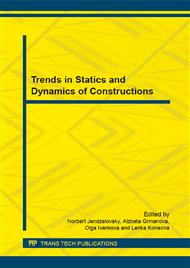[1]
CEB-FIB Model Code for Concrete Structures 2010, fib - International Federation for Structural Concrete, Ernst & Sohn, (2013).
DOI: 10.35789/fib.bull.0003
Google Scholar
[2]
Information on http: /www. scia-online. com.
Google Scholar
[3]
ANSYS, RELEASE 11 DOCUMENTATION FOR ANSYS, SAS IP, INC., (2007).
Google Scholar
[4]
C.K. Kim, M.H. Hwang, Non-linear analysis of skew thin plate by finite difference Metod, Journal Of Mechanical Science And Technology. 26 (2012), 4, 1127-1132.
DOI: 10.1007/s12206-012-0226-9
Google Scholar
[5]
W. F. Chen, Plasticity in Reinforced Concrete, Mc. Graw Hill, New York, (1982).
Google Scholar
[6]
J. Ravinger, M. Psotny, Analysis of structures. Nonlinear problems, STU, Bratislava, 2007. (in Slovak).
Google Scholar
[7]
G. Rombach, Application of Finite Element Method in Structural Concrete (In German: Anwendung der Finite-Elemente-Methode im Betonbau), 2. Auflage, Ernst & Sohn, Berlin, (2007).
DOI: 10.1002/stab.200001630
Google Scholar
[8]
O. Sucharda, J. Kubosek, Comparation of numerical methods for calculation of thin slabs, Advanced Materials Research. 969 (2014) 73-77.
DOI: 10.4028/www.scientific.net/amr.969.73
Google Scholar
[9]
ATENA Program Documentation, ATENA Studio. Cervenka Consulting, 2013. Information on http: /www. cervenka. cz.
Google Scholar
[10]
T. Yu, J.G. Teng, Y.L. Wong, S.L. Dong, Finite element modeling of confined concrete-I: Drucker-Prager type plasticity model, Engineering Structures. 32 (2010), 3, 665-679.
DOI: 10.1016/j.engstruct.2009.11.014
Google Scholar
[11]
MATLAB - The Language of Technical Computing. Software. [on-line]. <http: /matlab. com/>. The MathWorks, Inc., Massachusetts, USA, (2014).
Google Scholar
[12]
M. Krejsa, P. Janas, R. Cajka, Using DOProC method in structural reliability assessment, Applied Mechanics and Materials. 300-301 (2013) 860-869.
DOI: 10.4028/www.scientific.net/amm.300-301.860
Google Scholar
[13]
K. Tvrda, Probability and sensitivity analysis of plate, Applied Mechanics and Materials. 617, (2014) 193-196.
Google Scholar
[14]
K. Reißen, J. Hegger, Experimental investigations on the effective width for shear of single span bridge deck slabs, Beton- und Stahlbetonbau. 108 (2013), 2, 96–103.
DOI: 10.1002/best.201200064
Google Scholar
[15]
N. Jendzelovsky, K. Vrablova, Impact loading of concrete slabs, Applied Mechanics and Materials. 617 (2014) 100-103.
DOI: 10.4028/www.scientific.net/amm.617.100
Google Scholar
[16]
J. Kortis, The stress analysis of the industrial fiber-reinforced concrete slab on elastic subgrade loaded by the operational loading, Applied Mechanics and Materials. Vol. 617 (2014) 46-49.
DOI: 10.4028/www.scientific.net/amm.617.46
Google Scholar


